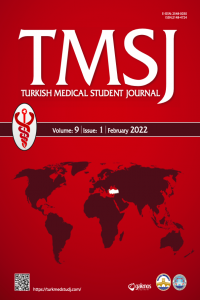THE RELATIONSHIP BETWEEN DIGIT RATIO (2D:4D) AND CARDIOVASCULAR CAPACITY IN YOUNG ADULTS
THE RELATIONSHIP BETWEEN DIGIT RATIO (2D:4D) AND CARDIOVASCULAR CAPACITY IN YOUNG ADULTS
Aims: The ratio of the second-to-fourth finger length was first proposed as a prenatal testosterone biomarker. Studying this matter with a different point of view, the aim of this study is to find whether there is a positive relationship between digit ratio and cardiovascular capacity.Methods: The data of 82 students who were between the ages of 18 and 25 old from Trakya University Faculty of Medicine were analyzed by evaluating the results of the six-minute walking test and the results of their digit measurements. Independent Samples T-Test was used to determine the correlation between the prevalence of longer 4th digit and six-minute walking test results.Results: The data obtained from the test results of the students, that were grouped regarding digit ratio, were statistically evaluated. With the results of the six-minute walking test, students that have lower digit ratio walked 593.87 ± 73.2 meters while students with higher digit ratio walked 584.17 ± 71 meters showing us that there is not a significant relationship between cardiovascular capacity and digit ratio.Conclusion: With the gathered information and results, it is seen that there is not a positive relationship between digit ratio and cardiovascular capacity. In conclusion it can be said that digit ratio does not have a beneficial effect on a persons cardiovascular capacity. Usage of digit ratio as a prenatal hormone exposure has been increasing, and extensive studies in physiological and psychological conditions in humans have been correlated with digit ratio, including athletic ability, fertility, social behaviors, sex-biased diseases, and sexual orientation
Keywords:
Fingers, androgenization, testosterone,
- ISSN: 2148-4724
- Başlangıç: 2014
- Yayıncı: Trakya Üniversitesi
Sayıdaki Diğer Makaleler
ASSESMENT OF PATIENT SATISFACTION OF IMPLANTABLE VENOUS PORT CATHETER USE: A SURVEY-BASED STUDY
Begüm Söyleyici, Ece Şenyiğit, Nur Gülce İşkan, Fazlı Yanık
THE RELATIONSHIP BETWEEN DIGIT RATIO (2D:4D) AND CARDIOVASCULAR CAPACITY IN YOUNG ADULTS
Fatih Erkan Akay, Betül Duran, Mehmet Can Keyfoğlu, Selçuk Yavuz
EVALUATING COMBINED EFFECT OF NARINGIN AND SALICYLIC ACID ON COLON CANCER CELL CULTURE
Kübra Gökçe, Nur Gülce İşkan, Nebiye Pelin Türker, Maide Kaşit
